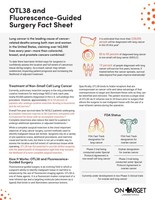Intraoperative Molecular Imaging of Non-Small Cell Lung Cancer Improves Outcomes for 26 Percent of Patients in Multi-Institutional Phase 2 Clinical Trial
OTL38 Receives FDA Fast Track Designation for Lung Cancer as it Begins Phase 3 Clinical Trials
WEST LAFAYETTE, Ind., Jan. 27, 2020 /PRNewswire/ -- On Target Laboratories, Inc., a privately-held biotechnology company developing the use of fluorescent markers to target and illuminate cancer during surgery, has announced the results of a multi-institutional Phase 2 clinical trial in which outcomes were improved for 26 percent of patients undergoing pulmonary resection for non-small cell lung cancer (NSCLC).
The results were presented today at the 56th Annual Meeting of the Society of Thoracic Surgeons (STS), held in New Orleans, LA., and were featured in a plenary session as a J. Maxwell Chamberlain Memorial Paper for General Thoracic Surgery, considered to be among the top-rated abstracts at STS.
"Our goal is to provide surgeons with new technology to help them provide a more complete resection to more patients. This gives patients the best chance of improved outcomes after surgery," said Christopher Barys, president and CEO of On Target Laboratories.
Lung cancer is the leading cause of cancer-related deaths in the United States. Pulmonary resection, either a wedge resection, segmentectomy, or lobectomy, is recommended for most patients who have operable stage I-II non-small cell lung cancer. Intraoperative molecular imaging (IMI)—also referred to as fluorescence-guided surgery—may increase the likelihood of a more complete surgical resection, which could translate into increased survival for patients and reduced re-operations or adjuvant treatment for hospitals.
Conducted over 18 months, the study included 92 patients eligible for analysis. There were no drug-related serious adverse events and 24 patients (26 percent) were impacted during pulmonary resection, with eight percent of patients having a change in their stage due to the use of IMI.
The study showed that IMI improved localization of small and peripheral lesions, which can be difficult for surgeons to identify visually or through manual palpitation, and enabled localization of otherwise unlocalizable lesions in 11 patients (12%). Further ten additional cancers were found in seven patients (8%). During the Specimen Check Phase, when the surgeon confirms the nodule is in the specimen and analyzes the margins, surgeons felt all margins were adequate, yet back-table inspection using IMI revealed inadequate margins in eight patients (9%).
"OTL38 is the first technique that is specific to imaging adenocarcinomas of the lung, which is one of the most common types of invasive lung cancer," said Inderpal (Netu) S. Sarkaria, MD, Department of Cardiothoracic Surgery at the University of Pittsburgh Medical Center in Pennsylvania. "Near-infrared imaging with OTL38 may be a powerful tool to help surgeons significantly improve the quality of lung cancer surgery by more clearly identifying tumors and allowing the surgeon to better see and completely remove them—one of the most vital components in the overall care of patients with this disease."
OTL38 is under development in two Phase 3 clinical trials for lung and ovarian cancer indications. Both trials are being conducted under a Special Protocol Agreement with the FDA. OTL38 has also received a Fast Track designation for both the lung and ovarian cancer indications and an orphan designation for ovarian cancer from the FDA.
About Intraoperative Molecular Imaging
To date, there have been limited ways for surgeons to confidently assess the location and full extent of cancerous tissue while operating. On Target Laboratories' fluorescent markers are comprised of a near-infrared dye and a targeting molecule, or ligand, that binds to receptors overexpressed on cancer cells. These markers illuminate the cancerous lesions, lighting the way for the resection of malignant tissue and enabling surgeons to see and remove more diseased tissue.
On Target's first novel compound, OTL38, targets folate receptors commonly found on many cancers, including lung and ovarian cancers. A small single dose of the compound is administered via IV infusion one to 24 hours before surgery, allowing the surgeon to identify malignant tissue during the procedure using the near-infrared camera.
About On Target Laboratories, Inc.
On Target Laboratories discovers and develops fluorescent markers to target and illuminate cancer during surgery so it can be removed more completely. Their intraoperative molecular imaging technology, based on the pioneering work of Philip S. Low, PhD, reduces the uncertainty associated with finding and removing diseased tissue during medical procedures, empowering surgeons to provide a more accurate and complete surgical resection. OTL38, the Company's first target compound molecule, is currently under development for use during surgery for ovarian and lung cancer and is not yet approved. For more information visit www.ontargetlabs.com.
SOURCE On Target Laboratories, Inc.

Related Links
WANT YOUR COMPANY'S NEWS FEATURED ON PRNEWSWIRE.COM?
Newsrooms &
Influencers
Digital Media
Outlets
Journalists
Opted In







Share this article